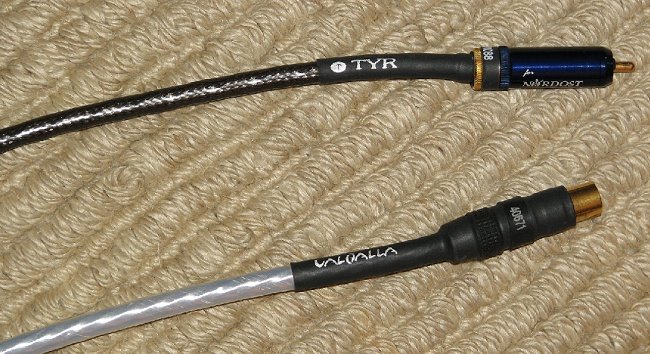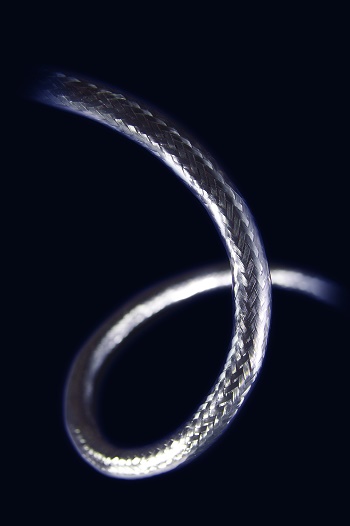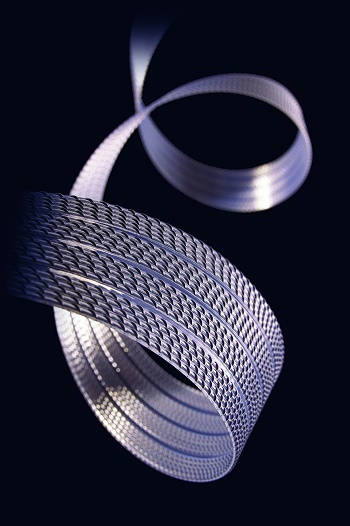Nordost Tyr Interconnects and Speaker Cables September, 2007 Jason Victor Serinus
|
|
|
|
Introduction
It's a strange feeling, sitting down to review high-end cables as the sound
of children jumping up and down and screaming in a huge inflatable device
reaches me through one set of open windows, while music and the scent of
grilled food waft through another. You never know what you'll encounter in
Oakland's barrio, except on Labor Day, when it is inevitably noisy and hot.
Even noise has its advantages, however. As I hear my wonderful neighbor,
José, rap away in a voice much too loud for comfort, I'm reminded of the
true timbre of voices. As overly-wired Buicks and Oldsmobiles drive down the
street with what passes for sound systems screaming, and as fenders rattle
and birds are silenced – I am not making this up – I remember how many
people raised on electronic music have no idea what natural as opposed to
overly bloated, out-of-control bass sounds and feels like.
All of which leads me to Nordost Tyr. Until Nordost recently announced the
arrival of their $14,000 Odin interconnects and $20,000 Odin speaker cables,
Tyr occupied second place in a Nordost cable hierarchy crowned by Valhalla.
But once Tara Labs came
out with a set of $15,000/pair interconnects that caused some reviewers to rave, and many,
many sets of eyes to bug, you could be sure that Nordost would follow suit
(and at $1,000 less for a set of top-of-the-line interconnects).
The Design
All high-end Nordost cables contain silver-plated copper solid-core
conductors. In Tyr's case, we are talking 60 microns of extruded silver over
99.9999% OFC. Tyr interconnect conductors have four 24 AWG solid core
conductors, while the speaker cables have twenty.
The
Nordost Valhalla power cables and Tyr interconnects boast dual
mono-filaments arranged in what Nordost claims are "Optimized Arrays." Both
Tyr and
Valhalla interconnects and speaker cables surround micro mono-filament
spiral spacing with extruded Teflon (Fluorinated Ethylene Propylene - FEP)
insulation to create a virtual air dielectric.
Nordost's combination of materials and construction is said to eliminate
conductor strand interaction, and reduce the audible distortions cause by
skin effect and magnetic field interactions (some will claim that the skin
effect does not involve frequencies in the audible band).
Very precise conductor spacing is used to keep capacitance and inductance extremely low. Nordost claims that micro-mono-filament technology increases signal bandwidth, resulting in cables that transmit signals at over 90% the speed of light. They have said, "This is 20 to 25% faster than conventional cables, resulting in a tremendous improvement in musical accuracy and clarity."
Yes, yes, I know that
doubting Thomas's out there will say this is all nonsense, and that all
cables sound the same. So, go use your 16 gauge lamp cord speaker cables and
leave us to our own devices here. We have a right to our opinions too.
Tyr speaker cables in particular share many visual similarities with their
shiny, silver big brothers. Examination combined with a rare skill at higher
mathematics reveals that Tyr has half as many conductors, and that its
conductors are spaced farther apart than Valhalla's. Both lines of
interconnects are pretty flexible – Tyr more so – while their Flatline
speaker cables easily curl around corners.


The Sound
What matters most, of course, is the sound. Much has been written about the
sound of Nordost Valhalla in these and other pages. With live music serving
as my reference, particularly as heard from prime orchestra seats in Davies
Symphony Hall (San Francisco Symphony), as well as the War Memorial Opera House (San
Francisco Opera), Valhalla has brought me closer to the sound of live,
full-range music than any other cable I've tried in my system. Its clarity
and transparency are extraordinary, as is its ability to convey the presence
of instruments and voices without altering timbre in any way.
Because Valhalla cable is so fast, I never have the sense that attacks are
delayed or softened, or that a romantic haze has settled over the music. Nor
do I feel that detail has been compromised or smudged over for the sake of
smoothness. Valhalla is an extremely honest cable that neither prettifies
nor beefs up sound. It may not deliver the fullest sound possible at lowest
frequencies, but unless one's room, speakers, and system are absolutely
dialed in to deliver huge amounts of bass without booming, a little less
bass usually translates into more of a good thing.
It would be nice if you could get the same detail and transparency from
other top-of-the-line audiophile cables as you can get with Valhalla. Sadly,
that is not often the case. During my last visits to the Rocky Mountain
Audio Fest and CES, I encountered a number of systems wired with a certain
well-known brand of cabling. (Until I hear this cabling in my reference
system, I am not comfortable mentioning its name). As I made mental note of
what I was hearing, I began to discover a common sonic signature: large
blocks of colorful sound, lacking ultimate top-end extension and detail. If
this cabling were used with speakers or electronics that were in any way
tipped up or tizzy, or with lower quality front ends that tended toward a
bright, metallic presentation, it did a wonderful job of smoothing things
over. Everything sounded beautiful, to a fault. No wonder some manufacturers
prefer it for their demos: it brought out the beauty of music while masking
the limitations of their equipment.
Tyr and Valhalla are another case entirely. Both cables reveal rather than
mask. After using Tyr for months in both our upstairs secondary system and
downstairs reference system, I'm convinced that it delivers virtually all of
Valhalla's clarity, transparency, and neutrality. Indeed, when it comes to
sparkling openness on high, lightning-fast presentation, and soundstage
width and depth, I would be hard pressed to differentiate between the two.
Take one of my favorite recordings, "Entre Amigos" featuring bossa nova
vocalist Rosa Passos in duet with bassist Ron Carter (Chesky). With Tyr,
every half-voiced whisper of the insinuating Passos comes through
beautifully, as does the musicality of Carter's acoustic bass and the
fullness of the guitar and other instruments. I've played this recording on
my Nordost-equipped system for countless audiophiles. In every case, they
have surrendered to Passos' vocal beauty. If you have an excellent system,
Tyr can make you feel as though you're right there in the recording studio,
with Passos purring directly at you.
While switching between Tyr and Valhalla, I wrote CD reviews of vocalist
Valerie Joyce's New York Blue (Chesky), the Tord Gustavsen Trio's Being
There (ECM), and Mozart Sacred Vocal Music (Covello). I loved the sound of
both cables, and could hear no major difference in presentation save for one
area: bass. When it comes to bass and lower midrange, the differences
between Tyr and Valhalla interconnects and speaker cables seem roughly
analogous to the difference between Valhalla and Vishnu power cords. The
Valhalla consistently delivers more full range sound.
Take the Chicago Symphony Orchestra's superb recent release of Mahler's
immense Symphony No. 3. Boasting one of the longest first movements in the
symphonic literature, plus a memorable "Urlicht" section sung by a
mezzo-soprano, Mahler's Third provides a major test for an audiophile
set-up.
Valhalla enables me to hear CSO's timpanis pounded to their limit, and
double basses sawing away at fortissimo levels. Tyr certainly transmits the
sound of those instruments, but not in as full a manner.
A Matter of Importance
What's most interesting is that, had I not initially heard Mahler's Third
performed live in the concert hall, I might not have realized that Tyr did
not convey timpani and basses with all the fullness and force of the live
experience. Why? Because Tyr's sonic presentation is so colorful,
transparent, and alive in the moment – so musical – that I was far more
taken by the beauty I was hearing than distracted by what was lacking.
The manner in which Tyr satisfied reminds me of the joys provided by many
bookshelf speakers. While organ and home theater DVD enthusiasts might only
be happy with full-range floor-standers augmented by high performance
subwoofers, many audiophiles are content with bookshelf or stand-mounted
speakers that do not extend below 80 Hz. This is because the sound they
deliver over most of the range is so musically satisfying.
Musicality is the key. Here's an example. Last night, the spouse and I spent
a spellbound few hours watching La Vie en Rose, the cinematic biography of
chanteuse Edith Piaf. For anyone who has heard it, Piaf's voice is as
recognizable as Billy Holiday's. First there's its husky, resilient quality,
the sound of someone who declares I am here no matter what. Then there is
the masterful use of vibrato, which she employed at the end of phrases to
give her declamations a unique singing quality. Finally, there was a
disarming flow to her singing that non-musical voices cannot reproduce.
Tyr is so musical that fixating on the question, "Is the glass half full or
half empty?", misses the point. Tyr has the astounding ability to reproduce
musical events as though there is hardly any cable between you and the real
thing. Its speed, openness, and neutrality set it apart from the pack.
Conclusions
Tyr interconnects and speaker cables maintain Nordost's reputation for lightning-fast, transparent sound.
Beyond their estimable neutrality of timbre, they convey the soul of music as
few cables do. Although they are neither the fullest nor richest sounding cables
on the market, their openness and clarity are instantly endearing. Depending
upon your listening preferences, they are a must-audition.
- Jason Victor Serinus -
Associated Equipment:
Digital
Front End
Theta Gen VIII DAC/Preamp
Theta Carmen II CD/DVD transport
Amplification
VTL 450W monoblock prototypes
Jadis DA-7 Luxe with GE 5751 Jan and Jan Philips 5814A tubes and cable from
Pierre Gabriel
Speakers
Talon Khorus X speakers MK. III (with latest upgrade and Bybee Quantum Noise
Purifiers)
Cables
Nordost Valhalla single-ended and balanced interconnects
Nordost Valhalla balanced digital interconnects
Nordost Valhalla bi-wired speaker cable
Nordost Tyr interconnects and speaker cables
Nordost Valhalla Power Cables
Elrod EPS-2 Signature power cables
Power Conditioners
Nordost Thor Power Distribution System
ExactPower EP15A equipped with outlets from Sound Applications and other
mods
IsoClean or other audiophile grade fuses in most components
Dedicated line for system
Analog
Clearaudio Emotion turntable with Satisfy arm
Benz MC-Gold phono cartridge
Classe 6 phono preamp
Accessories
Ganymede ball bearing supports
Acoustic Resonators
Michael Green Deluxe Ultrarack, Basic Racks and Corner Tunes
Echo Buster and Corner Busters
Shakti stones on transport, DAC, amps, and circuit breaker
Shakti Hallographs
Bedini Quadra Beam and Dual Beam Ultraclarifiers, Audioprism CD Stoplight,
Marigo Signature 3-D Mat v2; Ayre demagnetizing CD.
Main System Room Dimensions
24.5' deep, 21.4' wide in the listening area. The actual dimension at the
speaker end of the room is 37' wide, extending from the front door into the
living room through an 8.33' wide archway opposite the right channel speaker
to the rear wall of the dining room. Ceilings are 9' high with heavy wooden
cross-beams each 17” in height. Curtains cover windows behind the soundsystem. Floors are hardwood and carpet in front of the system, and
hardwood elsewhere. Walls in the living room are a combination of plaster
and wood, with a large granite fireplace in the rear. Dining room is all
plaster. There is RoomTune and Echo buster treatment in corners, and either
an Echo Buster or heavy tapestry at the two side wall first order reflection
points.
Upstairs Second System
Genesis I-60 Integrated amp
Von Schweikert VR-4jr. speakers
Proton TV
Basic Pioneer DVD player
Assortment of WireWorld Gold Eclipse 5, Harmonic Tech Magic One, and Nordost
Valhalla and Tyr cabling and Nordost Valhalla and AudioPrism SuperNatural S2
power cables
Also on hand and sometimes used
PS Audio P600 Power Plant power synthesizer with MultiWave II
Interconnects: WireWorld Gold Eclipse 5 and Gold Starlight 5 digital,
Harmonic Tech Magic One, Acoustic Zen Silver Reference II balanced, and
Nirvana BNC-terminated digital.
Power cables: Elrod EPS Signature 3 plus EPS 1, 2, and 3; WireWorld Silver
Electra 5; PS Audio X-treme Statement; and AudioPrism SuperNatural S2.
|
© Copyright 2007 Secrets of Home Theater & High Fidelity |





